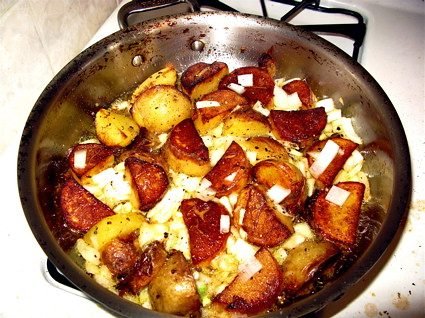Tuesday Techniques: Home Fries
Last week I started a series called Tuesday Techniques, a series where I cook my way through Jacques Pepin's Complete Techniques the same way that Top Chef Judge Tom Colicchio did at the start of his career. Already, I'm on shaky ground: (1) my Tuesday techniques posts always show up on Wednesday, but Wednesday Techniques doesn't have quite the same ring to it; (2) this week I didn't really use the Pepin book to work my chosen technique, I chose the technique first and picked up the book later.
The technique I chose was "home fries." I chose home fries because it was Sunday morning and I was going to make scrambled eggs and there were Yukon gold potatoes sitting on the counter. Now my normal Sunday breakfast fare is scrambled eggs with homemade biscuits or buttermilk pancakes. I don't make home fries, normally, because the truth is I don't know how to make home fries. They're a staple on your plate at a brunch restaurant, but I always take them for granted. Often they're disappointing: limp, greasy, under-seasoned.
So this Sunday I began my research. I did lots of Googling, I did open the Pepin book but his recipes for fried potato balls and soap-shaped potatoes didn't really fit the bill. He did speak eloquently about my chosen ingredient, though: "The potato is probably the greatest food contribution that the New World made to the Old....The potato is a versatile vegetable; it can be boiled, sauteed, baked, fried, steamed, broiled, stewed and so on."
The secret to making home fries, I soon discovered (after all my research) is a combination of two of those techniques: boiling and frying. First you boil, then you fry. It's that easy.
Here's how I did it:
1. I brought a big pot of water to a boil. I added salt and then dropped in five medium-sized Yukon gold potatoes and lowered the water to a simmer, covering the pot and walking away for 12 minutes. At that point, I started stabbing the potatoes with a knife to see if they were done. When the knife went in easily (another 5 mintutes later) I took the potatoes out and let them cool slightly.
2. I cut the cooled potatoes into wedges.
3. In a skillet, I heated a glug of olive oil (half a cup?) and 2 Tbs of butter (the butter for flavor). When it was bursting with heat, though before the butter burned, I added the potatoes which I dried with paper towels. Once the potaotes hit the hot fat I didn't move them at all. That's the secret to getting a perfect crust: not moving them.
4. While they sizzled and crackled, I took half an onion and chopped it into bits.
5. When the potatoes were golden and crusty on the bottom (about five minutes later), I flipped all the potato pieces and added the onion. I also sprinkled the whole thing with lots of salt and pepper.
6. I let the potatoes cook on the bottom (I made scrambled eggs in the meantime) and when everything was done, I plated. (I made the scrambled eggs with ramps I got from the green market the day before.)

Pretty, huh?
Amazing how something that seems so complex at a restaurant can be so easy at home. And now that it's been demystified, I feel like I can be much more discerning about the sub-standard home fries I'm frequently served on weekends. So thank you, Tuesday techniques. And sorry, Jacques Pepin. Next week I'm back to your book for more tutelage... readers, which technique would you like to see me tackle next?
Previous Techniques

